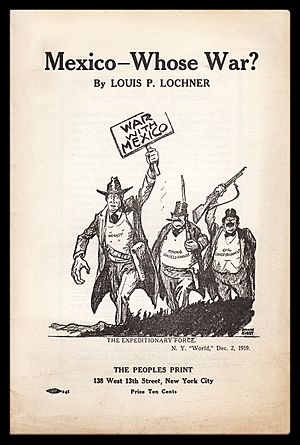Louis P. Lochner facts for kids
Ludwig "Louis" Paul Lochner (born February 22, 1887 – died January 8, 1975) was an American who worked as a journalist and writer. He was also a strong supporter of peace. During World War I, Lochner was a key leader in the movement against the war, both in America and around the world.
Later, he became famous for his work as a foreign correspondent (a journalist who reports from another country). He led the Berlin office of the Associated Press news agency for many years. Lochner won the 1939 Pulitzer Prize for his excellent reporting from Nazi Germany during the war. In December 1941, the Nazis held Lochner captive, but he was later freed in a prisoner exchange (where countries swap prisoners).
Contents
Early Life and Education
Louis Lochner was born on February 22, 1887, in Springfield, Illinois. His father was a Lutheran minister.
In 1905, Louis finished his studies at the Wisconsin Music Conservatory. He then went to the University of Wisconsin in Madison. He graduated in 1909 with a bachelor's degree and earned high honors.
Louis Lochner married Emmy Hoyer in 1910. They had two children, Elsbeth and Robert. Emmy passed away in 1920. Lochner married again in 1922 to Hilde De Terra. She had a daughter, Rosemarie, from her first marriage, who joined their family.
Working for Peace
In the early 1900s, Louis Lochner was a major leader in the American pacifist movement. Pacifists believe that all wars are wrong. In late 1914, he became the Executive Director of the Emergency Peace Federation in Chicago. He worked closely with social activist Jane Addams. They tried to get neutral countries to meet and help end World War I.
Lochner, Addams, and their group helped organize a big meeting in Chicago in February 1915. People from many anti-war and religious groups across the United States attended.
In 1915, Lochner became a secretary for Henry Ford, the famous car maker. He was in charge of public relations for Ford's "Peace Ship" trip, which aimed to end the war. He also served as the general secretary for the Neutral Conference for Continuous Mediation, which Ford also funded.
A Career in Journalism
After World War I ended in 1918, Lochner moved to Milwaukee, Wisconsin. He joined the staff of a newspaper called the Milwaukee Free Press. He also worked as an editor for a news agency called the International Labor News Service.
In 1924, Lochner started working for the Associated Press in Berlin, Germany. He stayed there until 1946. During this time, he interviewed Adolf Hitler twice, once in 1930 and again in 1933.
When Germany invaded Poland in 1939, starting World War II, Lochner was the first foreign journalist to follow the German Army into battle. He was very brave to stay in Nazi Germany and report the news fairly, even as war broke out. For his excellent reporting, he won the 1939 Pulitzer Prize for correspondence.
He continued to report on the German side of the war. He traveled with the German Army through the Netherlands, Belgium, and France. He even saw the 1940 French armistice (peace agreement) in Compiègne.
After Germany and the United States declared war in December 1941, the German government held Americans who were still in Germany. Lochner was held for about five months in Bad Nauheim, near Frankfurt am Main. He was released in May 1942 as part of a prisoner exchange.
After his release, Lochner took time off to travel across North America. He gave many speeches, warning people about the dangers of Nazism. During this time, he wrote a book called What About Germany? to warn about the dangers of fascist ideas.
From 1942 to 1944, Lochner worked as a news analyst and radio commentator for the National Broadcasting Company. He then went back to Europe as a war correspondent until the war ended.
After the War
In 1948, Louis Lochner translated and edited parts of the diary of Joseph Goebbels, who was a Nazi propaganda leader. This book became very popular. This led Lochner to write more non-fiction books. In the 1950s, he published three more books about German history and current events.
Lochner also returned to his Lutheran faith. He was on the editorial board of The Lutheran Witness and wrote columns for other Lutheran publications.
In 1955, Lochner published his own memories in a book called Stets das Unerwartete: Erinnerungen aus Deutschland 1921-1953. An English version, Always the Unexpected: A Book of Reminiscences, was published in 1956.
In his later years, Lochner wrote many articles for the journal of the Wisconsin Historical Society. This journal was published at his old university, the University of Wisconsin.
Death and Legacy
Louis Lochner passed away on January 8, 1975, in Wiesbaden, West Germany.
In 2005, a book of Lochner's German journalism was published after his death. It was called Journalist at the Brink: Louis P. Lochner in Berlin, 1922-1942.
Lochner's important papers are kept at the Concordia Historical Institute in St. Louis, Missouri. Many books from his personal library are now at Valparaiso University in Indiana. Lochner had given lectures there many times.
The records of Henry Ford's Peace Expedition from 1915–1916, which include some of Lochner's materials, are at Swarthmore College in Pennsylvania.
The papers of Lochner's son, Robert, are at the Hoover Institution archives at Stanford University in Palo Alto, California. These papers include photos and letters from Louis Lochner.
Images for kids





